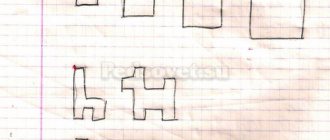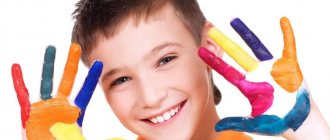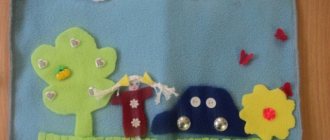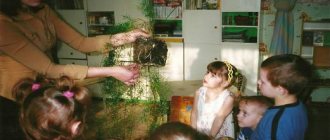MAGAZINE Preschooler.RF
“Development of fine motor skills in preschool children through didactic games”“The origins of children’s abilities and gifts are at their fingertips...” V.A. Sukhomlinsky
The problem of developing fine motor skills in preschool children is reflected in the “Federal State Standard of Preschool Education” . Fine motor skills are the ability to perform precise, coordinated movements with the fingers and hands. Fine motor skills are not only necessary in everyday life, they have a great impact on the child’s learning process. That is why, when diagnosing readiness for school, much attention is paid to how well the fine motor skills of preschoolers are developed. Fine motor skills are important when learning to write and draw: a person’s handwriting will, in particular, depend on the degree of development of these skills. In addition, the development of fine motor skills is closely related to the development of speech, since the areas of the cerebral cortex responsible for these functions are located very close to each other.
It is in preschool age that special attention should be paid to the development of fine motor skills: by the time the child goes to school, his motor skills must be developed at a sufficient level, otherwise learning at school will be difficult.
Working with preschool children, I encounter children’s problems such as poor development of the hands, impaired motor skills of the hands; in such children, slowness in performing movements predominates, and stiffness is observed. The child encounters problems when completing tasks, begins to be capricious, and his mood deteriorates.
Understanding the importance of this problem, I set myself goals and objectives.
Goal of the work:
- Development of fine motor skills in preschool children through didactic games.
Tasks:
- Improve the subject-development environment of the group for the development of fine motor skills.
- Develop fine motor skills of fingers in preschool children through educational games and toys.
- To develop the tactile sensitivity of children’s hands through didactic games and finger gymnastics.
Expected result:
- The subject-development environment has been improved;
- Positive dynamics in the development of children’s fine motor skills;
- Increases children's confidence in completing tasks and improves their mood.
Novelty:
It consists in revealing the theoretical, practical justifications for the psychological and pedagogical conditions for the development of fine motor skills of preschool children through methods and techniques, and also reveals the features of work in this direction and the effective way of its implementation.
At the beginning of her work, she conducted a diagnostic examination of the state of fine motor skills in children with the goal of identifying the level of development of fine motor skills of the hands. Diagnosis was carried out according to the following criteria:
Exercise "Lanterns" ; clenching and unclenching fists; rubbing fists; crumpling paper in a fist. The criteria are divided into three levels: high, medium, low. High level: accurate motion reproduction. Intermediate level: the basic elements of the movement are completed, but there are inaccuracies in execution. Low level: absence of basic elements in the movement structure. The diagnostics of the development of fine motor skills showed that 70% of newly arrived children have a low level of development of fine motor skills, and 30% have an average level of development.
The work was carried out in stages. At stage I, work was carried out with children, at stage II, work was carried out on joint activities of children with each other, individual work. At the third stage, work was carried out with parents: folders were made and displayed for parents: “Didactic games for the development of fine motor skills” , “Articulation exercises” , “Finger gymnastics” . Meetings were held, as well as individual conversations with parents of children with insufficiently developed hand motor skills “Developing fine motor skills at home” , simple games were offered, such as playing with sand “Find what’s hidden” , “Games in the kitchen” , working with mosaics , massage of the hands using various objects (cones, Sujoku balls, pencil).
To accomplish the assigned tasks, various methods and techniques were used:
Verbal method - verbal appeals from the teacher to children, explanations when examining visual objects. Since at the stage of formation of speech development it is difficult to simultaneously perceive the display of objects, actions with them and speech information, the explanation should be extremely brief: every extra word distracts the baby from visual perception.
A visual and effective method of teaching - at a young age, as is known, children become familiar with the objects around them through visual and sensory accumulation of experience: they look, pick them up, feel them, and in one way or another act with them. Taking into account this age feature, I try to widely use visual techniques: I show the object, give the opportunity to touch it, examine it.
Practical method - in order for knowledge to be acquired, it is necessary to apply it in practical activities. After a general demonstration and explanation, I propose to perform, under direct supervision, a fragment of the didactic game separately for each child, providing differentiated assistance as necessary, and giving individual instructions.
Game method - game methods and techniques occupy a large place in the education of preschool children. These include didactic games that raise their interest in the content of learning and provide a connection between cognitive activity and play activities characteristic of children. I often use game techniques; they help me a lot in getting children interested and learning the material better and faster.
To successfully solve the assigned problems, I selected and studied methodological literature on this topic: “New games with fingers for the development of fine motor skills” , Avanesova V.N. “Didactic games as a form of organizing education in kindergarten” , I.A. Ermakova “Developing fine motor skills in children”; A.E. Belaya “Finger games for the development of fine motor skills” ; as well as the monthly magazine "Preschool Education" . Based on this literature, I developed a long-term plan for the “Miracle Fingers” for the development of fine motor skills. I tried to create an environment surrounding the children in such a way that it determined the direction of their activities and at the same time solved the task of developing fine motor skills. The group has created the necessary subject-development environment, acquired games and aids for the development of fine motor skills, most of which were purchased and made independently and with the help of parents (during an announced competition in the group).
Conclusion:
By creating in the group the necessary developmental environment that promotes the development of fine motor skills, taking into account the age characteristics of children, receiving the support and assistance of parents helped to achieve the goal. Thus, as a result of the work done, I came to the conclusion that targeted, systematic and systematic work on the development of fine motor skills of children’s hands contributes to the formation of intellectual abilities, has a positive effect on the speech zones of the cerebral cortex, and most importantly, helps to preserve the physical and mental health of the child.
I would like to continue working next year on making and studying new games and game exercises on this topic.
| Next > |
Games and exercises aimed at developing fine motor skills
The main activity of preschool children is play. We have selected a variety of games and exercises for you, among which you will definitely find something that suits you and your child.
- Folding toys. We place a transparent container in front of the child and place small toys separately. We suggest putting toys into the container with your right hand. Then we pour them back and ask you to repeat the same actions with your left hand.
- Games with cereals. In one container we mix two types of cereals, for example, rice and buckwheat. It is necessary for the child to put these cereals into different containers. You can complicate the game by adding other small objects to the mixture of cereals, for example, beads, buttons, pebbles.
- Exercise for tearing a sheet of paper. First, draw random lines on a sheet of paper. We invite the child to tear the paper with his hands exactly along the drawn lines. You can complicate the task by depicting geometric shapes.
- Page turning exercise. As your child gets older, instead of tearing a sheet of paper, you can suggest flipping through the pages of a favorite book. This exercise also promotes the child's early interest in reading literature.
- Smoothing out a crumpled sheet of paper. We place a crumpled sheet of paper in front of the child and offer to smooth it out so that not a single bent corner remains. You can complicate the exercise by suggesting that you do it with one hand, while holding the sheet with your thumb.
- Games with cubes. We give the task to assemble various figures from cubes: a tower, a house, a car, etc. Pyramid rings are also suitable for these games. The tasks become more complicated as the child masters the construction of simple figures.
- Games with lacing. Available in various options. It can also be an unnecessary shoe that you can let your child lace and unlace. It could also be a card with holes for laces. In any case, the actions with these objects are the same and pursue the same goal - to teach the child to cope with shoelaces on his own, since this skill will be useful to him in the future.
- Exercises with counting sticks. Please place geometric shapes on the table. First, the child completes tasks according to the model, and then independently according to verbal instructions. An additional advantage of this exercise is the formation of elementary mathematical concepts.
- Games with lids. Here you can offer various containers and vessels with lids that the child will independently twist and unscrew. And if you tell your child that you can’t cope without him, you will give him a motive to become your main assistant.
- Finger drawing in the sand. Invite your child to draw geometric shapes or any other design he wishes with all his fingers one by one. Interaction with sand also has a positive effect on the central nervous system.
What are fine motor skills
Fine motor skills are the consistency and precision of movements required to perform various actions with small objects using the hands and fingers and toes.
Fine motor skills are evident in children from an early age, when they are just learning to hold a toy. First, the development of the hand and finger movements occurs, then the formation of speech is formed. The formation of speech through the development of fine motor skills occurs due to the influence of nerve endings on the parts of the brain responsible for motor skills and speech, which are located next to each other.
In addition to the main function - speech development - fine motor skills influence the development of mental processes: thinking, memory, imagination, and the ability to navigate in space.
At what age should you start developing fine motor skills?
You can develop and train the motor skills of your fingers from infancy, starting from 6-7 months of age through stroking the child’s palm, bending and straightening the fingers.
It is important to pay attention to hand motor skills for at least a few minutes every day.
- For children from nine months of age, large objects should be selected, for example, beads or pyramid rings.
- At the age of 1 year, you can organize games with natural materials: sand, clay, cones, pebbles, etc.
- After 2 years, the baby will happily perform finger gymnastics together with an adult. Saying various nursery rhymes simultaneously with hand movements will help teach hand and tongue coordination. And it will also be better remembered by the child himself.
- After 3 years, you should resort to exercises with paper. Usually by these years the child has mastered the skill of working with scissors, so it becomes possible to model appliqués.
- And from the age of 4-6 years, the skill of origami is mastered as one of the most difficult types of games with paper.
No matter what age you are developing fine motor skills in children, it is necessary to organize this activity so that it brings not only benefit to the child, but also pleasure.
The development of fine (fine) hand motor skills is extremely important for any child. This is explained by the fact that in the human brain the parts responsible for finger control and speech function are located next to each other, i.e. they can be mutually activated.
What are fine motor skills
Fine motor skills are the ability to operate small objects, pass objects to another person, and perform tasks that require hand-eye coordination. It is inextricably linked with the CNS (central nervous system), memory, vision and general perception of children.
At the initial stage of a child’s development, it is fine motor skills that indicate his intellectual abilities and general condition. Children who have insufficiently developed hand motor skills often drop pencils, forks, and spoons; it is difficult for them to lace up sneakers on their own, fasten zippers and buttons. In addition, it can be extremely difficult for them to collect scattered Lego pieces, assemble a mosaic, sort out counting sticks, etc. Therefore, such children often refuse appliqué and modeling and lag behind their peers during classes.
The importance of development
The correct development of fine motor skills contributes to the development of speech in a child, increasing his intellectual abilities and the desire for creative activity. In addition, it also affects manual dexterity, which in the future becomes the basis for reaction speed and one of the components of memory, logical thinking, prudence, imagination and attentiveness in children.
Therefore, activities for the development of fine motor skills with the help of didactic games must be included in the program for the development of speech, preparation for writing and the formation of self-care abilities in preschool children. Their subsequent development depends on how deftly children can learn to manipulate their own fingers.
Unfortunately, today many parents often forget about the importance of developing fine motor skills in children. Shoes and wardrobe items have Velcro instead of laces and buttons; not every child knits, embroiders, burns, saws with a jigsaw, helps parents wash toys, or sorts out cereals.
Today, the development of motor skills involves performing special exercises with the baby. At the same time, classes should not be boring for him, so they are organized in the form of useful and exciting didactic games.
What does it consist of?
The very first toy for any child is his hands. With their help, he begins to understand the world that surrounds him. The first tactile contact does not yet occur entirely consciously, but as the child grows older, he begins to consciously choose the movements of his fingers and hands. The subsequent development of a preschooler depends on the dexterity of finger control.
Development of fine motor skills includes:
formation of grasping movements - grabbing things of different sizes with 1 or 2 hands (balls, rattles, etc.);
grasping substances or objects with a pinch (3 fingers);
the formation of correlating actions - the ability to correctly combine 2 things or 2 parts of one thing (pyramids, inserts, nesting dolls, etc.);
development of finger control skills.
At first, the movements of the hands and fingers are clumsy, but then they become clearer and more accurate.
Age nuances
Didactic games are an excellent tool that helps comprehensively and effectively develop fine motor skills and speech function in children. Memorizing information using such gymnastics helps improve attentiveness, thinking and imagination. From an early age, children play such games as “White-sided Magpie”, “Ladushki”, etc. When bathing a baby, you can add additional devices to the games (small rubber expander, ball, etc.). In addition, after washing your baby’s hands, you can massage and wipe each of his fingers separately with a soft towel.
After 3 years, complex tasks can be introduced into games: sorting peas, beans, stringing large beads or buttons onto a string, screwing the lid of a jar or bottle, putting rings on fingers, attaching clothespins to a rope, modeling from dough, plasticine, assembling construction sets and puzzles, unfastening/fastening buttons, zippers, etc.
It is recommended to begin developing fine motor skills immediately after the baby is born. At first, you need to do a light massage, focusing on children's fingers. When the baby grows a little, he should be given toys with surfaces of different textures (rough, with pimples, smooth).
At 6 months of age, you need to buy special play equipment aimed at developing fine motor skills. Most often they have the form of a wire on which small multi-colored balls are hung. The baby must learn to move them from place to place.
At the age of 1 year, a child can already be given matryoshka dolls and pyramids of rings. Older children get construction sets with large details.
Preschool children are often offered modeling from dough or plasticine, drawing, making crafts, etc. These activities contribute to the effective development of motor skills of the child’s hands.
Popular and effective games
There are several effective exercises for preschoolers. Among them:
"Do as I do". An adult (parent or teacher) must draw some figure with his fingers. The baby must repeat the movements of the adult.
"Repeat after me". For this exercise, buttons of different colors are used. Dad, mom or teacher lays out a certain pattern on the table. The baby should draw the same figure, taking the buttons with his small fingers. If the child does not succeed the first time, the figure must be simplified and tried again. If in this case it doesn’t work out, then the child must come up with the pattern himself, and the adult repeats after him.
"Cinderella". This exercise promotes the effective development of fine motor skills. It is necessary to mix 2 types of cereals, for example, millet and peas, on a flat surface. After this, it is necessary to select the peas from the millet. To make the game as exciting as possible, you can try to compete with your child.
"A path of clothespins." Multi-colored clothespins can also provide all possible assistance in the development of motor functions. You need to take 10-15 multi-colored products and divide them into exactly 2 parts. One of the parts will be used by a child, and the other by an adult. After this, in the spirit of competition, the child should be asked to make a path out of clothespins. For this purpose, the clothespin clings to the tail one to the other.
"Kolobok smiles." First, on 2 A4 sheets you need to draw 2 buns with a nose and eyes (you don’t need to depict a smile yet). Then you need to give the baby 2 pieces of plastic mass (dough or plasticine) and ask him to make smiles for the drawn koloboks. For this purpose, the pieces are rolled out to form a long sausage. They need to be fixed in the drawings so that the koloboks get a sad or cheerful smile. Over time, the task can become more difficult. For example, you can make 2 sausages from plasticine at once, using both hands. You can also roll out the plasticine with one finger.
"Find the object." You should hide several toys in the children's sandbox. The child must try to find them by digging through the sand. This exercise is aimed at developing motor skills in children over 1-2 years old. In addition, it is undesirable to use soft toys for such games, because they will quickly become dirty.
You can come up with a large number of games yourself. For this purpose, you just need to turn on your imagination, and then everything will certainly work out!
But when performing any exercises, it must be borne in mind that they should be carried out exclusively under the supervision of an adult. This will help eliminate the possibility of small things getting into your baby's nose or mouth. In addition, it is prohibited to use prickly, sharp or other objects that could cause injury. When organizing finger games, you need to make sure that the baby’s hands are warm.
The main thing is to remember that kids develop much better when they are praised for what they do. Praise your kids even for minor achievements!






